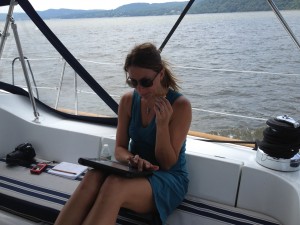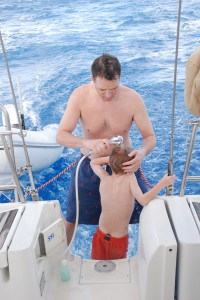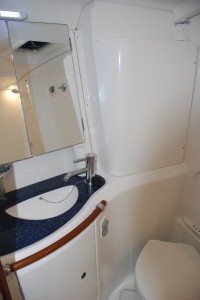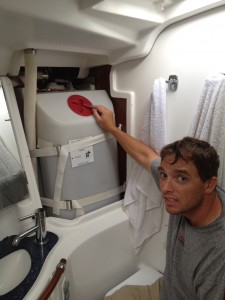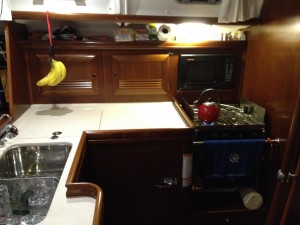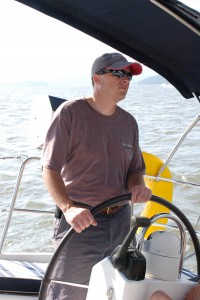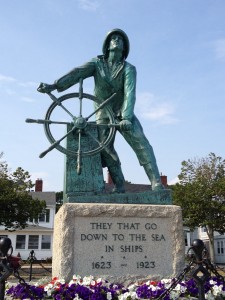So let’s get down and dirty. What are some of the things we are learning to adapt to as liveaboards?
WiFi: I thought about making my internet connection situation an entire blog post, but you can thank me right now for sparing you the whining. We haven’t yet figured it out despite our Alfa Booster Antenna, which picks up WiFi from a further distance. The problem is that there are all these WiFi connections available, but all of them require a security key, so we have to try each one until we find one that is unsecured. By then, our boat, which is swinging to and fro on its anchor, has lost the signal and we have to start all over again. Or better yet, I connect, get 89% finished with one of these blog posts and am uploading pictures, and THEN I lost the connection. Ok, seriously, don’t get me started. I can’t tell you how many times I have looked up in disgust from my laptop and said to Chris, “I can NOT do this for a whole year!” Clearly, I have much yet to learn in relaxing into the cruising lifestyle. Ok. I’m done. Carry on.
Showers: or a lack thereof. I’m a “shower within 15 minutes of waking up” kind of person. I am wont to say that my brain operates on hot water. I don’t really feel awake until I take my shower in the morning. I can probably count on two hands the number of days in the last few decades that I have not taken a shower. I think I may be close to reaching that number in the first three weeks of our trip! We are on day 20 and I have only taken 3 showers on the boat. The rest have been in yacht clubs, marinas, and at Lana and Dave’s house. During those times, I have almost sung out loud in joy at the luscious feeling of unlimited hot water. The only adjustment here is getting used to packing to go take a shower. It’s like being at camp. We have a bag ready to go with all the necessities, but I always end up forgetting some main ingredient, like a clean shirt, or my comb, or shampoo. I’m sure it will become second nature after a while.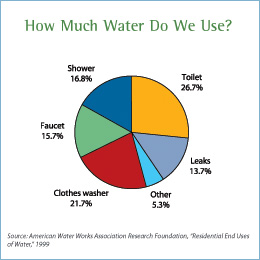
But why, why, why?!! Patronus can only carry 220 gallons of fresh water, which is actually quite a bit for a boat her size. But…the average American family of four can consume 400 gallons per day (see pie chart, epa.gov). We will probably fill our tanks an average of once a week (a little more in the US, a little less in the islands). So dishes, washing hands, and brushing teeth (all very quickly) take precedence over showers and swabbing the decks (yes, I know I can just say “washing the boat”, but I like sounding like a pirate sometimes). “Luckily” we don’t have a washing machine or a dishwasher, so our water usage is automatically less than the average home. Also, a lot of water is wasted on leaks, which we do NOT have! And households use a lot of water to flush toilets, whereas our toilets use seawater to flush (this makes for some great entertainment in the middle of the night, as phosphorescence streams through the bowl. Potty and a Show!)
So we have attempted to take our showers up on land whenever we can. Another reason to avoid showers on the boat is that we only have hot water if we have run the engine or generator recently. Which never seems to have been the case when you most desperately want to get clean. All three of my showers have been ice-cold. This has worked out well, because it made them last about 45 seconds each. A boat shower is not the sense-satisfying experience I am used to. You have to turn the water on to wet yourself and then turn it right off. You put in your shampoo and wash your body and then turn the water back on just to rinse off. Once we get out of the US, where water will be even harder to come by, our showers will be taken on the swim platform (the ledge on the back of the boat). Step One: Jump in the water. Step Two: Get out and wash yourself. Step Three: Jump back in to rinse. Step Four: Use the freshwater hose on the stern of the boat to rinse off the salt water. 10 seconds, max. I can’t wait….
Speaking of glow-in-the-dark toilets… We have two heads on the boat. Our non-sailing kid friends almost always ask why the bathroom is called the head, as they giggle their heads off. Well, in the old days of sail, the bathrooms were located at the “head” or “bow” of the boat. In order for a ship to move, the wind had to come from behind, catch the sails and move the ship. The wind would always move faster than the ship, thus carrying the smell away from the vessel (Stay tuned for more maritime facts from Wikipedia).Anyway, one head is next to the main salon (living room). It is a classic boat head, containing a sink and a toilet. In order to shower, you pull the faucet out and attach it to the wall. Yes. That means the whole entire bathroom gets soaked. Sink, mirror, toilet, walls, portholes, toothbrushes. And so it all has to get wiped down to avoid the most dreadful word in boating: mildew. I can tell you this. We will never use that head to shower.
The other head is up forward, in the main stateroom (bedroom). It has its own stall shower (I still hear the happy sounds of bells and wind chimes and trumpets every time I think about the fact that we found a boat with a stall shower). Granted, it is tiny. Do not, I repeat, do NOT drop the soap. Because you can’t bend down to pick it up. But it works and it is clean so I am happy. You know, the three times I took 45 second, freezing cold showers in it.
The toilets are also a fun and exciting experience. That is, if cleaning up after elephants at the zoo would be your dream job. The toilet in the main head is manual, which means you have to pump it up and down to flush it. That’s a lot of fun in the middle of the night. The other head has an electric toilet, so you only need to push two buttons to flush it. One allows water in, and one flushes everything out.
I know your next question but I’m not sure you want to know the answer. So if you are squeamish, just skip to the end, although I have been kind here and have omitted the graphic photographs (just kidding. Even this shutter-happy photographer has gladly kept the cameras away during the next part). So if you are still with me, you want to know where it all goes, right?
When we are “onshore”, which means within three miles of land, we flush the toilet into a holding tank, which stores the waste until we can get a “pumpout”. When we get to a harbor, we call the pumpout boat, which comes out and sucks out the waste from a hole on the deck of the boat. They use a hose and a machine that acts like a vacuum. Elephant-poop-picker-upper is sounding better and better, isn’t it? Needless to say, we hope to endure this process AS LITTLE AS POSSIBLE. So we have turned into drill sergeants on the boat, interrogating anyone who moves toward the head. “Do you REALLY have to go? Are you going to pee or poop?!!! Can it wait?!” In fact, Chris has recently instituted an incentive program, where you get a dollar every time you take care of your serious business on land. No, I am not kidding. Is that wrong? Isn’t there something in the parenting manual about not bribing. We’ll let the kids’ future therapists sort that one out. For now, we are preparing for the Caribbean, where pumpout boats are less available than in the US.
Here’s the part you won’t like. What? You are already gagging? Well guess what happens when we are more than three miles out to sea? We open the seacocks (openings in the hull) and flush the toilets directly into the ocean. Yup. Sorry. That’s the deal. To protect the environment, we will do this as little as possible, but two of our longer passages are 650 and 850 miles. With extra people on the boat to assist us, and two holding tanks…Well, you do the math.
Laundry: I actually like doing laundry. I had a whole system at home that worked well, even with a family of five that made 11 loads of laundry per week. So far, we have managed to have access to laundry when we have needed it (including about 15 loads of laundry at the Armitage house!). But in between, I have these moments of panic, thinking that we will run out of towels or underwear before we can get to the next laundry facility. Or that the slightly damp towel in the laundry bag will get mildew and cover all our clothes in little black spots. All worries with no basis in fact, so I think I will just relax for the next couple of weeks and see how it goes.
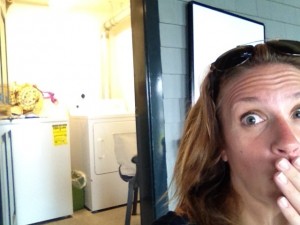
waiting for the lifeguard’s heavy towels to stop overheating the dryer. so bored i’m taking pictures of myself…
The nice thing is that sitting in the laundry room at a yacht club or marina is peaceful. A little quiet is lovely, and the white noise of the dryer lulls me into my meditation. Other times, I have enjoyed reading a book, working on my laptop, talking to a new laundry-room friend, or even swimming in a pool, as you read previously. Oh, and once I accidentally overheated a dryer, because I was finishing the lifeguard’s soaking wet towels for him. It took me two hours to fix. Oops!
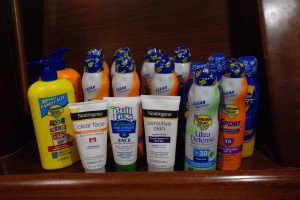 Suntan Lotion: You can tell I’m a Long Island child of the 70’s because I still insist on calling it Suntan Lotion, as opposed to the more appropriate “Sunblock” or “Sunscreen”. In my day, baby oil, Sun-In, and Ban de Soleil Dark Tanning Oil were de rigueur. I use suntan lotion about as enthusiastically as I wear my bike helmet-only ’cause I really gotta. I don’t like the greasy feeling (makes me want to take a shower, and we know how that goes.) I don’t like putting it on and getting my hands all messy. I don’t like that you need to track someone down to do your back. Chris is much better at it than I am and is in charge of making sure the kids get lubed up each morning. Go ahead and buy your stock in No-Ad , Coppertone, or BananaBoat now, because we are going through it like water. (BTW, we didn’t realize that some people don’t know about No-Ad. It’s a great one. No one in our sensitive-skinned family breaks out from it and it is well-priced. The name means “no advertising” and you can find it in supermarkets and pharmacies.)
Suntan Lotion: You can tell I’m a Long Island child of the 70’s because I still insist on calling it Suntan Lotion, as opposed to the more appropriate “Sunblock” or “Sunscreen”. In my day, baby oil, Sun-In, and Ban de Soleil Dark Tanning Oil were de rigueur. I use suntan lotion about as enthusiastically as I wear my bike helmet-only ’cause I really gotta. I don’t like the greasy feeling (makes me want to take a shower, and we know how that goes.) I don’t like putting it on and getting my hands all messy. I don’t like that you need to track someone down to do your back. Chris is much better at it than I am and is in charge of making sure the kids get lubed up each morning. Go ahead and buy your stock in No-Ad , Coppertone, or BananaBoat now, because we are going through it like water. (BTW, we didn’t realize that some people don’t know about No-Ad. It’s a great one. No one in our sensitive-skinned family breaks out from it and it is well-priced. The name means “no advertising” and you can find it in supermarkets and pharmacies.)
Dishes: not too much of an issue. We don’t have much space, so we don’t have a lot of dishes. Just enough to cook and eat for a family of five. Everything is on the small size, too. The galley is small, but it has a double sink, so we can wash on one side and drip dry on the other. We just have to keep on top of it so that it looks neat, and so we have dishes to use for the next meal.
Cooking/Food Storage: We’ve had a number of questions from friends and readers about the whole galley (kitchen) thing. I’ve been pleasantly surprised with how it is going. Our refrigerator is small, but we don’t carry much dairy or meat, and we don’t have all those condiments that filled the door shelves of our fridge at home. All in all, we are finding room for everything, even a gallon-sized jug of milk. The fridge does not stay very cold, and every time we open it, it loses a lot of energy. I am noticing that strawberries will not keep for more than a day or two. Everything else is hanging in there.
Better still, our freezer is AMAZING. It’s even more magical than our clothing locker (closet), if that is possible. When we moved aboard, I had 2 big coolers filled with freezer items from home. It ALL fit- with room to spare, even after adding two bags of ice. I’m still shocked at how big it is. We really liked a certain brand of boat, but we couldn’t consider it because the freezer is a tiny little shelf in the fridge that holds two ice cube trays (Note to non-sailors: the need to be vague about the boat manufacturer is because World War 7 will probably break out some day when one captain disses another captain’s boat. Don’t criticize another boat’s anchor, engine, fuel capacity, or even freezer. And definitely don’t do it on an internet boating forum!)
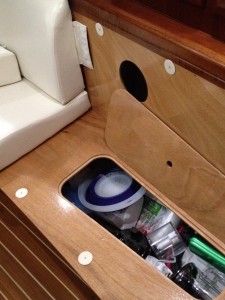 Anyhoo, our cold storage is adequate. Our dry storage is fine, but is proving to be just a little more of a hassle than I expected. It’s all that Velcro on the backs of our seat cushions. We have to move and set aside three cushions to get into each under-seat storage area. That’s a lot of Velcro. Today, I shuffled some things around so that the food is more easily accessible. So stay tuned, because next week I’ll be complaining that the shoes are too hard to get to…
Anyhoo, our cold storage is adequate. Our dry storage is fine, but is proving to be just a little more of a hassle than I expected. It’s all that Velcro on the backs of our seat cushions. We have to move and set aside three cushions to get into each under-seat storage area. That’s a lot of Velcro. Today, I shuffled some things around so that the food is more easily accessible. So stay tuned, because next week I’ll be complaining that the shoes are too hard to get to…
We are making a list of items to pick up to make cooking a little easier. We need a bigger pot, a large mixing bowl, and dry measuring cups. I thought we could manage with just a liquid measuring cup, but alas, no. We now know that we can store a larger pot and bowl, which I was skeptical about before we moved aboard. In all, we would like to continue to keep it simple. I think back to all the utensils and appliances in my kitchen at home and know that we will be able to get by just fine with the limited number of items we have on hand. It’s a bit freeing to think about it.
In addition to food and beverages, our galley provisioning includes:
Dinner plates, salad plates, bowls, and mugs for 8
4 aluminum bowls
4 tumblers
6 cups
10 Tupperware containers
Magma cookware: 4 pots, 1 frying pan
Can opener
Measuring cup and spoons
2 lobster crackers
Flatware for 10
4 serving spoons/forks
Whisk
Pasta fork
Spatula
Ladle
2 good knives
3 wine glasses
2 trays
Colander
Cruet for salad dressing
Cheese grater
2 Thermoses
Pitcher
Blender
Food Saver and bags (vacuum sealer)
Food chopper
4 reusable water bottles
Stick blender
If you have more general questions about living on a boat, comment here and I’ll address them in the next episode of Living the Life Aquatic:) Future topics may include sleeping, eating, maintenance/cleaning, leisure, and what our days at sea are like. All good stuff…

